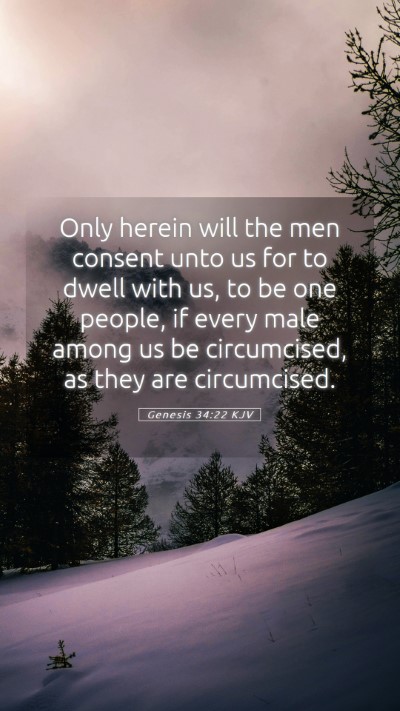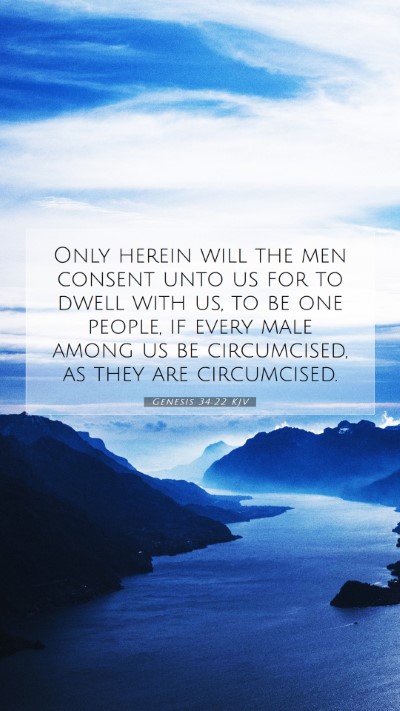Understanding Genesis 34:22 - A Comprehensive Bible Verse Commentary
The verse Genesis 34:22 states:
"But on the condition that they circumcise every male among us, then we will give our daughters to you and we will take your daughters for ourselves, and we will dwell with you and become one people."
This verse is part of a larger narrative involving the events that transpired after the violation of Dinah, the daughter of Jacob, by Shechem, the son of Hamor. This passage presents a critical moment in the unfolding story, showcasing themes of covenant, family, and the consequences of sin.
Contextual Analysis
To understand Genesis 34:22 thoroughly, it’s essential to consider its context. Dinah's situation leads to a tense negotiation between Jacob's family and the people of Shechem. The call for circumcision becomes a pivotal condition that influences the relationship dynamics between these two groups.
The Significance of Circumcision
Circumcision was a physical sign of the covenant between God and Abraham and symbolized identity and commitment among the Israelites. By demanding this condition, the sons of Jacob not only sought justice for their sister but also aimed to integrate the Shechemites into their covenant community.
Key Themes
- Covenant Relationships: The demand for circumcision indicates the importance of covenant in the Israelite faith, symbolizing a deeper connection that transcends mere intermarriage.
- The Role of Justice: Jacob's sons respond to the injustice done to Dinah, illustrating the necessity of justice intertwined with cultural practices.
- Family and Identity: This verse reflects upon the struggles of maintaining identity amidst cultural intersection, a recurrent theme throughout the Bible.
Biblical Exegesis: Insights from Commentators
Here we'll combine insights from notable public domain commentaries to glean further meanings of this pivotal verse. Each commentator provides valuable perspectives that enhance our Bible verse understanding.
Matthew Henry's Commentary
Henry emphasizes the treachery involved in the proposal made by Dinah's brothers. He notes that the terms demanded—circumcision—were both a means of manipulation and a pursuit of justice. It illustrates how the brothers were willing to go to great lengths to defend their sister’s honor, albeit through deceptive means.
Albert Barnes' Commentary
Barnes points out that this demand for circumcision reflects the deep social and spiritual implications of the covenant. He interprets this act as a potential means of conversion for the Shechemites, indicating that the Israelites were inviting them into a relationship with God. This commentary aligns with themes of acceptance and the transformative power of covenantal relationships.
Adam Clarke's Commentary
Clarke provides historical context regarding the significance of male circumcision among ancient peoples. He notes the cultural implications that such a ritual held, thereby enhancing the understanding of Jacob's sons' motivations beyond mere vengeance.
Implications for the Modern Reader
The implications of Genesis 34:22 resonate with modern audiences seeking to apply biblical teachings to daily life. By examining this passage, we come to understand the complexities of family dynamics, justice, and the importance of spiritual commitments. It challenges readers to reflect on their own commitments and the lengths to which they would go to protect loved ones.
Cross References
- Genesis 17:10 - The covenant of circumcision given to Abraham.
- Exodus 12:48 - The requirement of circumcision for participation in Passover.
- Joshua 5:2-9 - The Israelites’ renewed commitment to circumcision before entering the Promised Land.
Conclusion
Genesis 34:22 is a multifaceted verse that encapsulates themes of justice, covenant, and identity. By exploring Bible verse explanations and engaging in Bible study insights, readers can appreciate the depth of Scripture and its application to our lives today.
For those involved in Bible study groups or engaging in online Bible study, this passage offers rich material for discussion and reflection on how ancient practices influence modern faith.


